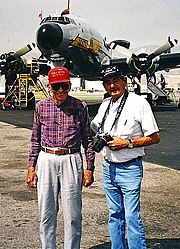
Joe Ware opening the Joseph F. Ware, Jr., Advanced Engineering Laboratory, the "Ware Lab," at Virginia Tech

Jack Real, left; Willis Hawkins, center; Joseph Ware, Jr., right

Ware Lab Plaque at Virginia Tech

Joseph F. Ware, Jr., left; Gil Cefaratt, right
Joseph Fulton "Joe" Ware, Jr. (November 8, 1916 - April 23, 2012)[1] was a military flight test engineer.
Biography[]
Ware was born and raised in Blacksburg, VA, at 404 Clay St. He enrolled at Virginia Polytechnic (now Virginia Tech) aged 15 and attended the Guggenheim Aeronautical Laboratory at the California Institute of Technology aged 20, graduating with a Master's in Aeronautical Engineering a year later in 1938. He worked as a test engineer at the Wright engine test facility at Paterson, New Jersey, then instructed mathematics at Virginia Polytechnic, when he was hired as a flight test engineer at Lockheed in 1941,[2] a few months before the attack on Pearl Harbor, December 7, 1941.
Ware also served in the Civil Air Patrol. After retiring from Lockheed in 1974, he engaged in an active career in the U.S. Coast Guard Auxiliary, attaining the rank of Commander. A lifelong pilot, and holding a Commercial certificate, Joe Ware flew flag officers of the Coast Guard in his personal aircraft and engaging in search and rescue operations with same, and anti-terrorist activities with the Coast Guard on his boat.
Ware was the flight test engineer in charge of numerous advanced military and reconnaissance aircraft at the Skunk Works, Lockheed, from 1941 to 1974, including but not limited to the Hudson Bomber, the P-38 Lightning, the AT-22 (Flight Engineer Trainer, Sheppard Field, TX) during WW-II, the YP-80A, all radial-engined and turbo-prop variants of the Constellation, including (serial number) "1961" (Howard Hughes' former personal airplane which was used at Lockheed as an engine and prototype testbed) and the WV-2E (roto-dome prototype), Columbines II and III (which were Air Force Ones for President Dwight D. Eisenhower), the P-2 series, the YP-3V1 Orion prototype and series including the P-3A&B, the YC-130 Hercules, the Model 286, Lockheed's XH-51 and AH-56 Cheyenne helicopters, the F-104 Starfighter, Lockheed's space shuttle proposal, and was also Department Manager of Engineering Flight Test for the U-2 and the SR-71.[3]
Many good friendships were formed during his career, including those shown in these photographs with Jack Real, Willis Hawkins, and Gil Cefaratt, Lockheed tech rep and technical writer.
After retirement, Ware founded the Joseph F. Ware, Jr. Advanced Engineering Laboratory at Virginia Tech.[1]
References[]
- ↑ 1.0 1.1 "About Joseph F Ware Jr". VirginiaTech College of Engineering. http://www.eng.vt.edu/warelab/about_joe_ware. Retrieved 13 June 2014.
- ↑ Good, Timothy (2012). A Need to Know: UFOs, the Military and Intelligence. Pan Macmillan. ISBN 978-0-330-54349-1.
- ↑ Cefaratt; Gill (2002). Lockheed: The People Behind the Story. Turner Publishing Company. ISBN 978-1-56311-847-0.
The original article can be found at Joseph F. Ware, Jr. and the edit history here.